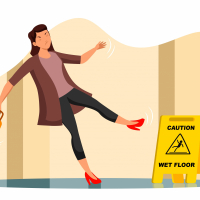
Key messages
For older adults at a higher risk of having a fall, such as having had a fall in the past year and recently hospitalised or needing support with daily activities, removing environmental fall hazards in the home can reduce the number of falls by 38%. Examples of environmental fall hazards are a stairway without railings, a slippery pathway, or poor lighting.
Why is it important to consider environmental hazards as part of a fall prevention programme?
Falls are common and can be deadly, but they are preventable. Approximately one-third of people age 65 years and older fall each year. Most falls occur in the home, and more than 30% of all falls are caused by environmental hazards. Environmental fall-hazard removal programmes are interventions delivered by professionals that identify and remove environmental fall hazards.
What did we want to find out?
We wanted to find out:
• which types of environmental programmes work best to prevent falls.
We also wanted to find out for these programmes that prevent falls:
• the best ways to deliver programmes that reduce environmental fall hazards; and
• if such programmes can prevent falls that result in serious injury.
We examined four types of programmes, including those that:
• focused on removing fall hazards in and about the home;
• only provided assistive devices such as up-to-date glasses or special footwear;
• only provided education about environment-related fall risk; and
• focused on home modifications to enable independence and performance of daily tasks in the home.
What did we do?
We searched for studies that investigated different types of environmental fall-hazard programmes for older adults who live in the community. We compared and summarised the results of the studies and rated our confidence in the evidence, based on factors such as study methods and sample sizes.
What did we find?
We found 22 studies involving 8463 older adults that lived in the community. The study participants were on average 78 years of age, and 65% were women. The studies were conducted in 10 countries. Most studies followed up participants for 12 months.
Main results
A programme that removes fall hazards in the home given to older adults that live in the community can reduce the number of falls.
We are not certain if assistive devices (such as checking prescription for glasses, special footwear, or bed alarm systems) can reduce the risk of a fall.
We are not certain if just giving an older adult who lives in the community education about fall risk has any impact on reducing risk of falls.
We found no completed studies that helped us answer our question about fall reduction for home modification programmes targeting independence in daily activity performance.
We found little evidence to determine if environmental fall-hazard removal programmes of any kind reduce the risk of serious injury.
How up-to-date is the evidence?
The evidence is current to January 2021.

